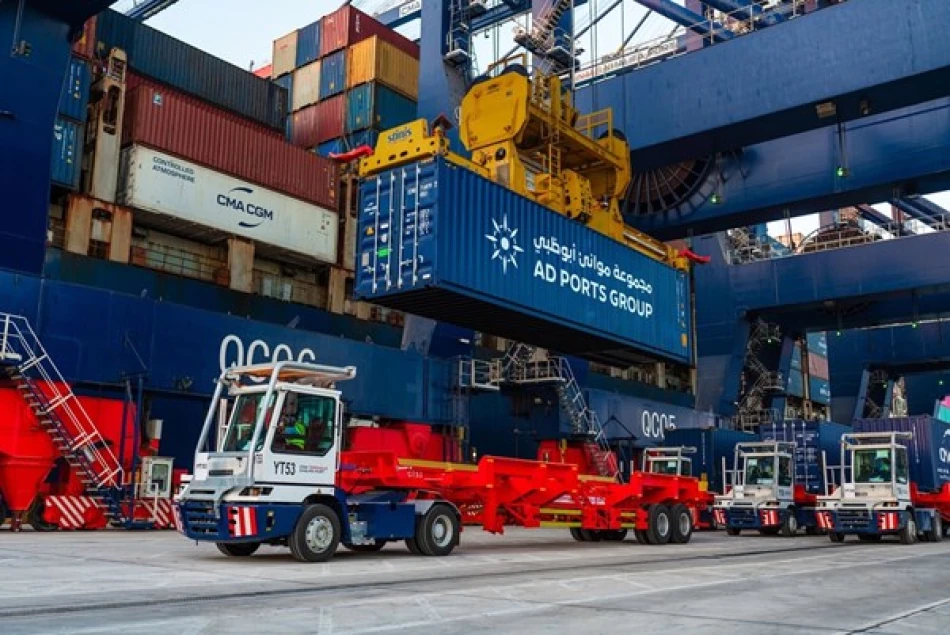
Abu Dhabi Ports Generates AED 4.83 Billion in Revenues During Q2
Abu Dhabi Ports Delivers 15% Revenue Growth as Middle East Trade Routes Reshape Global Logistics
Abu Dhabi Ports Group has posted impressive Q2 2025 results with revenues climbing 15% year-on-year to AED 4.83 billion, demonstrating how strategic positioning and operational excellence can capitalize on shifting global trade patterns. The strong performance across ports, economic cities, free zones, and maritime sectors signals the UAE's growing dominance as businesses seek alternatives to traditional shipping routes disrupted by regional tensions and tariff wars.
Financial Performance Reflects Strategic Positioning
The company's financial metrics reveal a business hitting its stride during a period of global trade uncertainty. EBITDA rose 9% to AED 1.17 billion, maintaining a healthy 24.2% margin that demonstrates pricing power and operational efficiency. While net profits remained relatively stable at AED 445 million due to higher depreciation and financing costs, the underlying business fundamentals appear robust.
Perhaps most tellingly, operating cash flow nearly doubled to AED 1.14 billion, with an exceptional 97% cash conversion rate. This performance suggests the company is not just growing revenues but converting that growth into real cash generation—a critical factor for investors in capital-intensive infrastructure businesses.
Operational Excellence Drives Growth
Container Volumes Surge as Trade Routes Shift
The ports division delivered exceptional container handling growth of 17% year-on-year, while general cargo volumes increased 13%. This outperformance likely reflects businesses redirecting shipments through UAE ports as Red Sea disruptions and geopolitical tensions make traditional routes less reliable.
The newly operational CMA Terminals Khalifa Port facility exemplifies this trend, achieving 80% capacity utilization in Q2 and 62% since beginning commercial operations in early 2025. Such rapid ramp-up typically takes years in the port industry, suggesting strong underlying demand for alternative routing solutions.
Economic Cities and Free Zones Gain Traction
The company leased an additional 600,000 square meters during Q2, bringing total land leased since year-start to 1.6 square kilometers. This expansion reflects businesses establishing regional headquarters and manufacturing bases in the UAE as companies implement "China+1" strategies and seek geopolitically neutral locations.
Particularly notable is the 80% residential occupancy rate achieved by Saadiyat Group properties, up from 63% in Q2 2024. This suggests the UAE is successfully attracting not just businesses but the skilled workforce needed to support them long-term.
Capital Allocation Shows Disciplined Growth Strategy
Capital expenditure of AED 928 million represents 19% of revenues, down from 28% in Q2 2024. This declining capex intensity while maintaining strong growth suggests improving asset utilization and more selective investment decisions. The focus on maritime, free zone, and port assets aligns with where the company sees the strongest demand drivers.
The positive free cash flow generation both quarterly and year-to-date provides flexibility for opportunistic acquisitions or shareholder returns while maintaining growth investments.
Market Implications and Investment Perspective
Abu Dhabi Ports' performance illustrates how infrastructure companies positioned at critical trade junctions can benefit from global supply chain reconfiguration. Unlike pure-play shipping companies suffering from route disruptions, integrated port operators with diversified service offerings can capture value from trade flow redirection.
The 34% increase in regional container shipping volumes suggests the company is successfully building hub-and-spoke networks that could prove durable even after current disruptions resolve. This positions Abu Dhabi Ports similarly to how Singapore and Hong Kong became permanent fixtures in global trade networks during previous geopolitical shifts.
Looking Forward: Sustainable Competitive Advantages
CEO Captain Mohamed Juma Al Shamisi's emphasis on the company's "synergistic and flexible business model" reflects a key competitive advantage. By combining ports, logistics, economic zones, and maritime services, the company can offer end-to-end solutions that pure-play competitors cannot match.
The focus on Central Asia trade corridors and Red Sea alternatives suggests management recognizes these disruptions as permanent shifts rather than temporary challenges. This strategic positioning could establish Abu Dhabi Ports as an indispensable link in emerging trade networks, potentially generating returns for decades rather than quarters.
For investors, the combination of strong cash generation, disciplined capital allocation, and positioning at the intersection of major trade route changes makes Abu Dhabi Ports a compelling infrastructure play on the reshaping of global commerce.
 Layla Al Mansoori
Layla Al Mansoori







